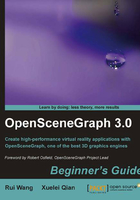
上QQ阅读APP看书,第一时间看更新
Why OSG?
The OSG project is open sourced and released under a modified GNU Lesser General Public License (LGPL), named OSGPL. It brings about significant benefits to its users:
- Rigorous structure: OSG makes full use of the Standard Template Library (STL) and multiple design patterns. It also takes advantage of the open source development model in order to provide a legacy-free and user-centric application programming interface.
- Superior performance: A series of scene graph techniques are already well-implemented in OSG, including view-frustum and occlusion culling, level of detail (LOD) configuration, rendering state sorting, particle and shadow supports, and complete encapsulation of OpenGL extensions and the shader language.
- High scalability: The core OSG functionalities are clean and highly extensible. This makes it easy for users to write their own NodeKits and file I/O plugins, and integrate them into scene graphs and applications.
- Software and hardware portability: The core OSG is already designed to have minimal dependency on any specific platform or windowing system, requiring only Standard C++ and OpenGL. This provides great convenience in being able to rapidly port OSG-based applications to Windows, Linux, Mac OSX, FreeBSD, Solaris, and even embedded platforms.
- Latest activity: With an active developer community, OSG is growing at an incredible speed. It supports the latest OpenGL and OpenGL ES extensions and various graphics concepts and techniques, along with a great deal of feedback in the development cycle.
- Open source: In modern industry, open source means co-intelligence, quality and flexibility, rather than merely inexpensive. Users and companies also don't have to worry about software patent violations when using OSG in their own applications.